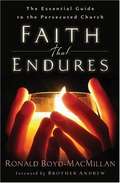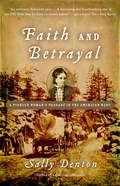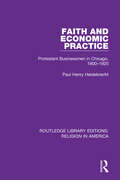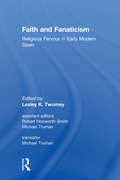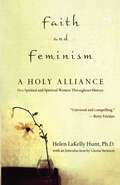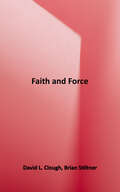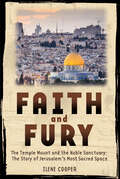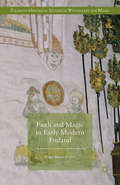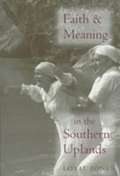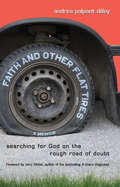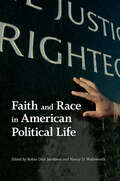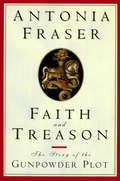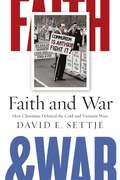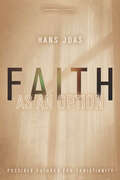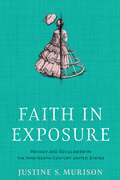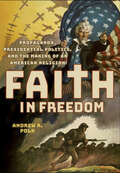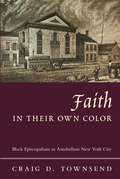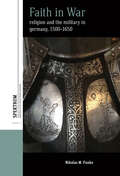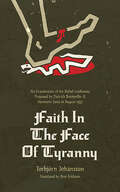- Table View
- List View
Faith That Endures: The Essential Guide to the Persecuted Church
by Ronald Boyd-MacmillanIn many underprivileged countries, the church is under constant persecution. Christians everywhere have heard the stories and seen the newscasts. But there are too many who still don't understand. What does persecution really look like up close? And what can we learn from the faithful endurance persecuted Christians so boldly embody? Ronald Boyd-MacMillan, writer-at-large for Open Doors International, has produced the most compelling and comprehensive look at Christian persecution today. With real life stories, he educates readers on the many levels of church persecution, highlights testimonies that have never before been published, and shows what we all can do to remember, reflect, and respond. Compassionate and provocative, Faith That Endures gives readers a path of connection to their persecuted brothers and sisters in a new and vital way, even as it enlightens and encourages us in our local churches and brings us closer to God.
Faith and Betrayal: A Pioneer Woman's Passage in the American West
by Sally DentonIn the 1850s, Jean Rio, a deeply spiritual widow, was moved by the promises of Mormon missionaries and set out from England for Utah. Traveling across the Atlantic by steamer, up the Mississippi by riverboat, and westward by wagon, Rio kept a detailed diary of her extraordinary journey. In Faith and Betrayal, Sally Denton, an award-winning journalist and Rio's great-great-granddaughter, uses the long-lost diary to re-create Rio's experience. While she marvels at the great natural beauty of Utah, Rio's enthusiasm for her new life turns to disillusionment over Mormon polygamy and violence against nonbelievers, as well as the harshness of frontier life. She sets out for California, where she finds a new religion and the freedom she longed for. Unusually intimate and full of vivid detail, this is an absorbing story of a quintessential American pioneer.
Faith and Economic Practice: Protestant Businessmen in Chicago, 1900-1920
by Paul Henry HeidebrechtFirst published in 1989, Faith and Economic Practice: Protestant Businessmen in Chicago, 1900-1920 ponders the role that religion played in North American society in the 20th Century. Written against the backdrop of a religious resurgence in American society, represented by such phenomena as the Moral Majority, television preachers, prayer breakfasts, parochial schools, brainwashing cults, anti-pornography campaigns and organizations established for the purpose of restoring Judeo-Christian values, the volume examines both the religious milieu and the larger environment in which it functions. Through studying businessmen in Chicago who were both leading actors in a capitalist society and Protestant church members with personal religious agendas, the books explores the interactions between religious expression and economic order and the role of religion in capitalism with the purpose of assessing the extent to which their religious views were shaped by their business experience and social outlook as the wealthy elite of society.
Faith and Fanaticism: Religious Fervour in Early Modern Spain
by Robert Hooworth-SmithThe Spanish Inquisition is often seen as the archetype of religious fervour and fanaticism, and several of the papers here naturally focus on its activities. Overall, however, this volume aims to look at the broader context of religious attitudes in Spain, from the end of the 15th to the late 17th century. In an examination of how the religious orders behaved, the contributors demonstrate that concepts which may now appear excessive were perceived at that time. Similarly, poetry and other literary texts provide evidence for how Jews viewed Christians and Christians viewed Moors.
Faith and Feminism: A Holy Alliance
by Helen LaKelly HuntWhy do so many women of faith have such a strong aversion to feminism? And why do so many feminists have an ardent mistrust of religion? These questions are at the heart of Helen LaKelly Hunt's illuminating look at the alliance between spiritual conviction and social action. Intelligent and heartfelt, Faith and Feminism offers a perceptive look at the lives of five spirited and spiritual women of history, women who combined their undying faith with feminist beliefs and who made the world a better place by doing so. St. Teresa of Ávila, a woman whose bravery in confronting her shadows gave her the strength to connect with the world and live a life of divine action. Lucretia Mott, a Quaker minister, who rose from her quiet upbringing to become a passionate speaker and activist working tirelessly on behalf of justice and peace. Sojourner Truth, a Christian slave, who spoke out with unwavering courage to claim her God-given rightful place as an African American and a woman. Emily Dickinson, an extraordinary poet, who touched the world with her ability to capture and transform the experience of suffering. Dorothy Day, a radical journalist, who lived a life of voluntary poverty as a way of expressing her passion for the Christian faith and care for those in need. A remarkable book that focuses on the idea that spirituality and feminism are really different expressions of the same impulse to make life more whole, Faith and Feminism offers a powerful catalyst for reflecting on our sense of self -- and for living and loving according to our deepest values.
Faith and Force: A Christian Debate about War
by David L. Clough Brian StiltnerThis book began in an argument between friends, surprised to find themselves on opposite sides of the debate about whether the United States and the United Kingdom should invade Iraq in 2003. Situated on opposite sides of the Atlantic, in different churches, and on different sides of the just war/pacifist fence, we exchanged long emails that rehearsed on a small scale the great national and international debates that were taking place around us. We discovered the common ground we shared, as well as some predictable and some surprising points of difference....When the initial hostilities ended, our conversation continued, and we felt the urgency of contributing to a wider Christian debate about whether and when war could be justified. - From the Preface. So began a dynamic collaboration that developed into a civil but provocative debate over matters of war and peace that is Faith and Force. From the ancient battles between Greek city-states to the Crusades to the World Wars of the twentieth century to the present-day wars in Afghanistan and Iraq and the Middle East, aggressors and defenders alike have claimed the mantle of righteousness and termed their actions just. But can the carnage of war ever be morally grounded? And if so, how? These are the questions that David L. Clough, a Methodist proponent of pacifism, and Brian Stiltner, a Catholic theologian and just war adherent, have vowed to answer―together. With one voice, Clough and Stiltner outline and clarify issues of humanitarian intervention, weapons proliferation, and preventative war against rogue states. Their writing is grounded in Christian tradition and provides a fresh and illuminating account of the complexities and nuances of the pacifist and just war positions. In each chapter Clough and Stiltner engage in debate on the issues, demonstrating a respectful exchange of ideas absent in much contemporary political discourse―whether on television or in the classroom. The result is a well-reasoned, challenging repartee that searches for common ground within the Christian tradition and on behalf of the faithful promotion of justice―yet one that also recognizes genuine differences that cannot be bridged easily. Intended for a broad audience, Faith and Force is the perfect foil to the shrill screeching that surrounds partisan perspectives on military power and its use. To help with using the book in a classroom context, the authors have provided Questions for Reflection and Discussion for each chapter.
Faith and Fury: The Temple Mount and the Noble Sanctuary: The Story of Jerusalem's Most Sacred Space
by Ilene CooperVeteran author Ilene Cooper explores the turbulent history of one of Jerusalem's most sacred sites in this timely, illustrated nonfiction offering, Faith and Fury: The Temple Mount and the Noble Sanctuary. Towering over the Old City of Jerusalem is a place where worlds meet, conflict arises, and history changes. Known to Jews as the Temple Mount, it was once the site of the great temples built by Solomon and Herod. To Muslims, it is the Noble Sanctuary and home to one of the most sacred buildings in the Muslim world, the Dome of the Rock. Venerated by Jews, Muslims, and Christians alike, it attracts pilgrims and tourists from around the world—and is the focus of the bitter and intractable conflict between Israel and the Arab world that dominates today's news.
Faith and Magic in Early Modern Finland (Palgrave Historical Studies in Witchcraft and Magic)
by Raisa Maria ToivoEarly modern Finland is rarely the focus of attention in the study of European history, but it has a place in the context of northern European religious and political culture. While Finland was theoretically Lutheran, a religious plurality – embodied in ceremonies and interpreted as magic – survived and flourished. Blessing candles, pilgrimages, and offerings to forest spirits merged with catechism hearings and sermon preaching among the lay piety. What were the circumstances that allowed for such a continuity of magic? How were the manifestations and experiences that defined faith and magic tied together? How did western and eastern religious influences manifest themselves in Finnish magic? Faith and Magic in Early Modern Finland shows us how peripheral Finland can shed light on the wider context of European magic and religion.
Faith and Meaning in the Southern Uplands
by Loyal JonesOne of Appalachian religion's most eloquent spokesmen reveals people devoted to and thoughtful about their religion, and profoundly influenced by it. In their own voices these people describe their beliefs, their churches, and their lives, exposing a deep conviction tempered with humanity and humor.
Faith and Money
by Lisa A. KeisterFor those who own it, wealth can have extraordinary advantages. High levels of wealth can enhance educational attainment, create occupational opportunities, generate social influence and provide a buffer against financial emergencies. Even a small amount of savings can improve security, mitigate the effects of job loss and other financial setbacks and improve well-being dramatically. Although the benefits of wealth are significant, they are not enjoyed uniformly throughout the United States. In the United States, because religion is an important part of cultural orientation, religious beliefs should affect material well-being. This book explores the way religious orientations and beliefs affect Americans' incomes, savings and net worth.
Faith and Other Flat Tires: A Memoir
by Andrea Palpant DilleyAt age twenty-one, Andrea Palpant Dilley stripped the Christian fish decal off her car bumper in a symbolic act of departure from her religious childhood. At twenty-three, she left the church and went searching for refugein the company of men who left her lonely and friends who pushed the boundaries of what she once held sacred.In this deeply personal memoir, Andrea navigates the doubts that plague believers and skeptics alike: Why does a good God allow suffering? Why is God so silent, distant, and uninvolved? And why does the church seem so dysfunctional?Yet amid her skepticism, she begins to ask new questions: Could doubting be a form of faith? Might our doubts be a longing for God that leads to a faith we can ultimately live with?
Faith and Race in American Political Life (Race, Ethnicity, and Politics)
by Robin Dale Jacobson and Nancy D. WadsworthDrawing on scholarship from an array of disciplines, this volume provides a deep and timely look at the intertwining of race and religion in American politics. The contributors apply the methods of intersectionality, but where this approach has typically considered race, class, and gender, the essays collected here focus on religion, too, to offer a theoretically robust conceptualization of how these elements intersect--and how they are actively impacting the political process.ContributorsAntony W. Alumkal, Iliff School of Theology * Carlos Figueroa, University of Texas at Brownsville * Robert D. Francis, Lutheran Services in America * Susan M. Gordon, independent scholar * Edwin I. Hernández, DeVos Family Foundations * Robin Dale Jacobson, University of Puget Sound * Robert P. Jones, Public Religion Research Institute * Jonathan I. Leib, Old Dominion University * Jessica Hamar Martínez, University of Arizona * Eric Michael Mazur, Virginia Wesleyan College * Sangay Mishra, University of Southern California * Catherine Paden, Simmons College * Milagros Peña, University of Florida * Tobin Miller Shearer, University of Montana * Nancy D. Wadsworth, University of Denver * Gerald R. Webster, University of Wyoming
Faith and Treason: The Story of the Gunpowder Plot
by Antonia FraserIn England, November 5 is Guy Fawkes Day, when fireworks displays commemorate the shocking moment in 1605 when government authorities uncovered a secret plan to blow up the House of Parliament--and King James I along with it. A group of English Catholics, seeking to unseat the king and reintroduce Catholicism as the state religion, daringly placed thirty-six barrels of gunpowder in a cellar under the Palace of Westminster. Their aim was to ignite the gunpowder at the opening of the Parliamentary session. Though the charismatic Catholic, Robert Catesby, was the group's leader, it was the devout Guy Fawkes who emerged as its most famous member, as he was the one who was captured and who revealed under torture the names of his fellow plotters. In the aftermath of their arrests, conditions grew worse for English Catholics, as legal penalties against them were stiffened and public sentiment became rabidly intolerant.In a narrative that reads like a gripping detective story, Antonia Fraser has untangled the web of religion, politics, and personalities that surrounded that fateful night of November 5. And, in examining the lengths to which individuals will go for their faith, she finds in this long-ago event a reflection of the religion-inspired terrorism that has produced gunpowder plots of our own time.
Faith and War: How Christians Debated the Cold and Vietnam Wars
by David E SettjeThroughout American history, Christianity has shaped public opinion, guided leaders in their decision making, and stood at the center of countless issues. To gain complete knowledge of an era, historians must investigate the religious context of what transpired, why it happened, and how. Yet too little is known about American Christianity’s foreign policy opinions during the Cold and Vietnam Wars. To gain a deeper understanding of this period (1964-75), David E. Settje explores the diversity of American Christian responses to the Cold and Vietnam Wars to determine how Americans engaged in debates about foreign policy based on their theological convictions. Settje uncovers how specific Christian theologies and histories influenced American religious responses to international affairs, which varied considerably. Scrutinizing such sources as the evangelical Christianity Today, the mainline Protestant ,Christian Century, a sampling of Catholic periodicals, the African Methodist Episcopal Church, the Southern Baptist Convention, and the United Church of Christ, Faith and War explores these entities' commingling of religion, politics, and foreign policy, illuminating the roles that Christianity attempted to play in both reflecting and shaping American foreign policy opinions during a decade in which global matters affected Americans daily and profoundly.
Faith as an Option: Possible Futures for Christianity
by Hans Joas translated by Alex SkinnerMany people these days regard religion as outdated and are unable to understand how believers can intellectually justify their faith. Nonbelievers have long assumed that progress in technology and the sciences renders religion irrelevant. Believers, in contrast, see religion as vital to society's spiritual and moral well-being. But does modernization lead to secularization? Does secularization lead to moral decay? Sociologist Hans Joas argues that these two supposed certainties have kept scholars from serious contemporary debate and that people must put these old arguments aside in order for debate to move forward. The emergence of a "secular option" does not mean that religion must decline, but that even believers must now define their faith as one option among many. In this book, Joas spells out some of the consequences of the abandonment of conventional assumptions for contemporary religion and develops an alternative to the cliché of an inevitable conflict between Christianity and modernity. Arguing that secularization comes in waves and stressing the increasing contingency of our worlds, he calls upon faith to articulate contemporary experiences. Churches and religious communities must take into account religious diversity, but the modern world is not a threat to Christianity or to faith in general. On the contrary, Joas says, modernity and faith can be mutually enriching.
Faith in Empire: Religion, Politics, and Colonial Rule in French Senegal, 1880-1940
by Elizabeth A. FosterFaith in Empire is an innovative exploration of French colonial rule in West Africa, conducted through the prism of religion and religious policy. Elizabeth Foster examines the relationships among French Catholic missionaries, colonial administrators, and Muslim, animist, and Christian Africans in colonial Senegal between 1880 and 1940. In doing so she illuminates the nature of the relationship between the French Third Republic and its colonies, reveals competing French visions of how to approach Africans, and demonstrates how disparate groups of French and African actors, many of whom were unconnected with the colonial state, shaped French colonial rule. Among other topics, the book provides historical perspective on current French controversies over the place of Islam in the Fifth Republic by exploring how Third Republic officials wrestled with whether to apply the legal separation of church and state to West African Muslims.
Faith in Exposure: Privacy and Secularism in the Nineteenth-Century United States (Early American Studies)
by Justine S. MurisonRecent legal history in the United States reveals a hardening tendency to treat religious freedom and sexual and reproductive freedom as competing, even opposing, claims on public life. They are united, though, by the fact that both are rooted in our culture’s understanding of privacy. Faith in Exposure shows how, over the course of the nineteenth century, privacy came to encompass such contradictions—both underpinning the right to sexual and reproductive rights but also undermining them in the name of religious freedom.Drawing on the interdisciplinary field of secular studies, Faith in Exposure brings a postsecular orientation to the historical emergence of modern privacy. The book explains this emergence through two interlocking stories. The first examines the legal and cultural connection of religion with the private sphere, showing how privacy became a moral concept that informs how we debate the right to be shielded from state interference, as well as who will be afforded or denied this protection. This conflation of religion with privacy gave rise, the book argues, to a “secular sensibility” that was especially invested in authenticity and the exposure of hypocrisy in others.The second story examines the development of this “secular sensibility” of privacy through nineteenth-century novels. The preoccupation of the novel form with private life, and especially its dependence on revelations of private desire and sexual secrets, made it the perfect vehicle for suggesting that exposure might be synonymous with morality itself. Each chapter places key authors into wider contexts of popular fiction and periodical press debates. From fears over religious infidelity to controversies over what constituted a modern marriage and conspiracy theories about abolitionists, these were the contests, Justine S. Murison argues, that helped privacy emerge as both a sensibility and a right in modern, secular America.
Faith in Freedom: Propaganda, Presidential Politics, and the Making of an American Religion
by Andrew R. PolkIn Faith in Freedom, Andrew R. Polk argues that the American civil religion so many have identified as indigenous to the founding ideology was, in fact, the result of a strategic campaign of religious propaganda. Far from being the natural result of the nation's religious underpinning or the later spiritual machinations of conservative Protestants, American civil religion and the resultant "Christian nationalism" of today were crafted by secular elites in the middle of the twentieth century. Polk's genealogy of the national motto, "In God We Trust," revises the very meaning of the contemporary American nation.Polk shows how Presidents Franklin D. Roosevelt, Harry S Truman, and Dwight D. Eisenhower, working with politicians, advertising executives, and military public relations experts, exploited denominational religious affiliations and beliefs in order to unite Americans during the Second World War and, then, the early Cold War. Armed opposition to the Soviet Union was coupled with militant support for free economic markets, local control of education and housing, and liberties of speech and worship. These preferences were cultivated by state actors so as to support a set of right-wing positions including anti-communism, the Jim Crow status quo, and limited taxation and regulation.Faith in Freedom is a pioneering work of American religious history. By assessing the ideas, policies, and actions of three US Presidents and their White House staff, Polk sheds light on the origins of the ideological, religious, and partisan divides that describe the American polity today.
Faith in Markets: Christian Capitalism in the Early American Republic (Columbia Studies in the History of U.S. Capitalism)
by Joseph P. SlaughterIn the first half of the nineteenth century, the United States saw both a series of Protestant religious revivals and the dramatic expansion of the marketplace. Although today conservative Protestantism is associated with laissez-faire capitalism, many of the nineteenth-century believers who experienced these transformations offered different, competing visions of the link between commerce and Christianity. Joseph P. Slaughter offers a new account of the interplay between religion and capitalism in American history by telling the stories of the Protestant entrepreneurs who established businesses to serve as agents of cultural and economic reform.Faith in Markets examines three Christian business enterprises and the visions of a Christian marketplace they represented. Shaped by Pietist, Calvinist, and Arminian theologies, each offered different answers to the question of what a moral, Christian market should look like. George Rapp & Associates operated sophisticated textile factories as the business side of the model community the Harmony Society, which practiced communal living in pursuit of a harmonious workforce. The Pioneer Stage Coach Line provided transportation services only six days a week to keep Sunday sacred, attempting to reform society by outcompeting less pious businesses. The publisher Harper & Brothers sought to elevate American culture through commerce by producing virtuous products like lavishly illustrated Bibles. Drawing on a wide range of sources, Faith in Markets explores how the founders and owners of these enterprises infused their faith into their businesses and, in turn, how distinctly religious businesses shaped American capitalism and society.
Faith in Objects
by Erin L. HasinoffIn the early twentieth century, missionary expositions were a central event in the religious life of many Americans. Hasinoff brings the untold history of the World in Boston of 1911, "America's First Great Missionary Exposition,"to light, focusing on how the material culture of missions shaped domestic interactions with evangelism, Christianity, and the consumption of ethnological knowledge. "
Faith in Paper: The Ethnohistory and Litigation of Upper Great Lakes Indian Treaties
by Charles E. ClelandFaith in Paper is about the reinstitution of Indian treaty rights in the Upper Great Lakes region during the last quarter of the 20th century. The book focuses on the treaties and legal cases that together have awakened a new day in Native American sovereignty and established the place of Indian tribes on the modern political landscape. In addition to discussing the historic development of Indian treaties and their social and legal context, Charles E. Cleland outlines specific treaties litigated in modern courts as well as the impact of treaty litigation on the modern Indian and non-Indian communities of the region. Faith in Paper is both an important contribution to the scholarship of Indian legal matters and a rich resource for Indians themselves as they strive to retain or regain rights that have eroded over the years. Charles E. Cleland is Michigan State University Emeritus Professor of Anthropology and Curator of Anthropology and Ethnology. He has been an expert witness in numerous Native American land claims and fishing rights cases and written a number of other books on the subject, including Rites of Conquest: The History and Culture of Michigan's Native Americans;The Place of the Pike (Gnoozhekaaning): A History of the Bay Mills Indian Community; and (as a contributor)Fish in the Lakes, Wild Rice, and Game in Abundance: Testimony on Behalf of Mille Lacs Ojibwe Hunting and Fishing Rights.
Faith in Their Own Color: Black Episcopalians in Antebellum New York City
by Craig D. TownsendOn a September afternoon in 1853, three African American men from St. Philip's Church walked into the Convention of the Episcopal Diocese of New York and took their seats among five hundred wealthy and powerful white church leaders. Ultimately, and with great reluctance, the Convention had acceded to the men's request: official recognition for St. Philip's, the first African American Episcopal church in New York City. In Faith in Their Own Color, Craig D. Townsend tells the remarkable story of St. Philip's and its struggle to create an autonomous and independent church. His work unearths a forgotten chapter in the history of New York City and African Americans and sheds new light on the ways religious faith can both reinforce and overcome racial boundaries. Founded in 1809, St. Philip's had endured a fire; a riot by anti-abolitionists that nearly destroyed the church; and more than forty years of discrimination by the Episcopalian hierarchy. In contrast to the majority of African Americans, who were flocking to evangelical denominations, the congregation of St. Philip's sought to define itself within an overwhelmingly white hierarchical structure. Their efforts reflected the tension between their desire for self-determination, on the one hand, and acceptance by a white denomination, on the other. The history of St. Philip's Church also illustrates the racism and extraordinary difficulties African Americans confronted in antebellum New York City, where full abolition did not occur until 1827. Townsend describes the constant and complex negotiation of the divide between black and white New Yorkers. He also recounts the fascinating stories of historically overlooked individuals who built and fought for St. Philip's, including Rev. Peter Williams, the second African American ordained in the Episcopal Church; Dr. James McCune Smith, the first African American to earn an M.D.; pickling magnate Henry Scott; the combative priest Alexander Crummell; and John Jay II, the grandson of the first chief justice of the Supreme Court and an ardent abolitionist, who helped secure acceptance of St. Philip's.
Faith in Their Own Color: Black Episcopalians in Antebellum New York City (Religion and American Culture)
by Craig TownsendOn a September afternoon in 1853, three African American men from St. Philip's Church walked into the Convention of the Episcopal Diocese of New York and took their seats among five hundred wealthy and powerful white church leaders. Ultimately, and with great reluctance, the Convention had acceded to the men's request: official recognition for St. Philip's, the first African American Episcopal church in New York City. In Faith in Their Own Color, Craig D. Townsend tells the remarkable story of St. Philip's and its struggle to create an autonomous and independent church. His work unearths a forgotten chapter in the history of New York City and African Americans and sheds new light on the ways religious faith can both reinforce and overcome racial boundaries. Founded in 1809, St. Philip's had endured a fire; a riot by anti-abolitionists that nearly destroyed the church; and more than forty years of discrimination by the Episcopalian hierarchy. In contrast to the majority of African Americans, who were flocking to evangelical denominations, the congregation of St. Philip's sought to define itself within an overwhelmingly white hierarchical structure. Their efforts reflected the tension between their desire for self-determination, on the one hand, and acceptance by a white denomination, on the other.The history of St. Philip's Church also illustrates the racism and extraordinary difficulties African Americans confronted in antebellum New York City, where full abolition did not occur until 1827. Townsend describes the constant and complex negotiation of the divide between black and white New Yorkers. He also recounts the fascinating stories of historically overlooked individuals who built and fought for St. Philip's, including Rev. Peter Williams, the second African American ordained in the Episcopal Church; Dr. James McCune Smith, the first African American to earn an M.D.; pickling magnate Henry Scott; the combative priest Alexander Crummell; and John Jay II, the grandson of the first chief justice of the Supreme Court and an ardent abolitionist, who helped secure acceptance of St. Philip's.
Faith in War: Religion and the Military in Germany, c.1500-1650 (Spektrum: Publications of the German Studies Association #31)
by Nikolas M. FunkeWhile the social and cultural history of the early modern military has greatly advanced in the last few decades, the religious dimension of the military life in the Holy Roman Empire between 1500 and 1650 has hardly been explored. The Reformation brought profound political, social and cultural upheavals, but the religiosity of the men and women who followed the Christian life in the chaos of war still represents a large gap in the historiography. Faith in War shows that confessional antagonisms lost much of their meaning during war and coexistence became a fact of army life. Connecting military and civilian social and cultural history in these ways, Nikolas Funke’s case study on this period brings new life to important current historiographical discussions in a military context, including stereotyping, confessionalization, social discipline, deviance, toleration, religious violence, and the culture of death.
Faith in the Face of Tyranny: An Examination of the Bethel Confession Proposed by Dietrich Bonhoeffer and Hermann Sasse in August 1933
by Torbjörn JohannsonIn 1933 a group of theological students in Berlin asked Dietrich Bonhoeffer and Hermann Sasse to work together with other theologians to come up with a confession that could be used to challenge nazi ideology and its inroads into the church bodies of Germany through the so-called "German Christians" who wanted to reshape Christianity into a worship of German ethnicity. The result was the August Bethel Confession named after the town in which Sasse and Bonhoeffer worked together. Unfortunately, church bureaucrats got a hold of it and watered it down, and then it was forgotten for the Barmen Declaration what was much more heavily influenced by Reformed theology and concerns and failed to even take up the question of what place Jews had in the church.This was a huge disappointment to both Bonhoeffer and Sasse who are largely regarded as two of the greatest Lutheran theologians of that era. In Faith in the Face of Tyranny, Torbjö rn Johannson takes a look at the work that both these men brought to the forgotten Bethel Confession to show just what a confessional response to national socialism and racism looks like. Today there are often calls for new confessions and declarations addressing different political ideologies and issues and well as cultural movements. This book shows what such a confession should look like and why as well as what considerations should be taken into account when looking at such a project.
